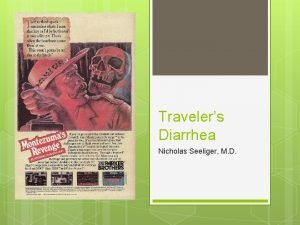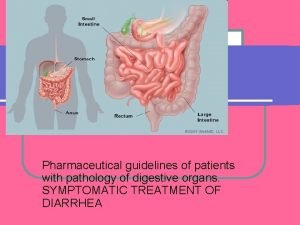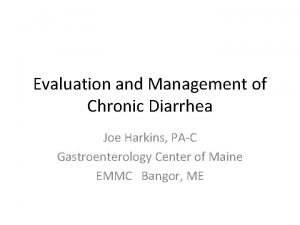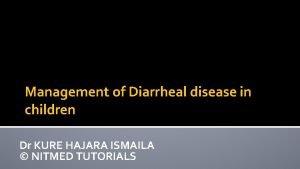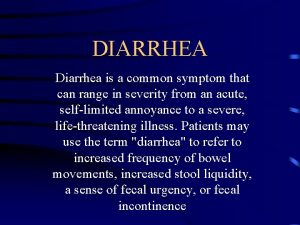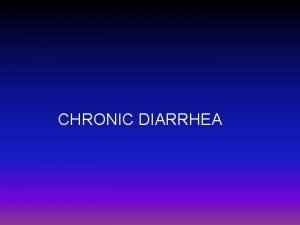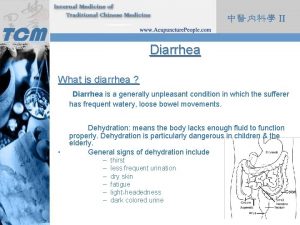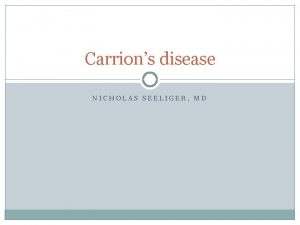Travelers Diarrhea Nicholas Seeliger M D Travelers Diarrhea










- Slides: 10

Traveler’s Diarrhea Nicholas Seeliger, M. D.

Traveler’s Diarrhea diarrheal syndrome which may be caused by a variety of intestinal pathogens contracted while traveling, particularly in developing countries formally defined as ≥ 3 loose stools in 24 -hour period with ≥ 1 accompanying systemic or enteric symptom, such as fever, nausea, vomiting, or abdominal cramps bacteria account for majority of cases, but traveler's diarrhea may also be caused by parasites or viruses

Epidemiology most common travel-associated disease, affecting 30%-70% of travelers traveler's diarrhea most common illness among returned travelers most frequent identified pathogens were Campylobacter, Salmonella, or Shigella specific parasitic cause identified in 20% most frequently identified parasite was Giardia

Risk Factors travel destination is most significant risk factor for traveler's diarrhea high-risk areas include South Asia, the Middle East, Africa, and Latin America other risk factors for traveler's diarrhea include poor hygiene and inadequate public health practices in handing or preparation of food and beverages in restaurants inadequate electrical capacity, water supplies, or plumbing facilities pregnancy young age achlorhydria or taking histamine H 2 blockers or proton pump inhibitors

Risk Factors vegetables may be contaminated with coliform bacteria based on analysis of raw and cooked vegetable samples from Mexico (64 samples) and Texas (67 samples) comparing Mexico vs. Texas, coliform contamination overall 42% vs. 25% (p = 0. 04) in cooked vegetables 67% vs. 10% (p < 0. 001) tabletop sauces may be contaminated with causative organisms of traveler's diarrhea based on analysis of 96 samples of tabletop sauces from restaurants in Guadalajara, Mexico and Houston, Texas Escherichia coli was grown from 40% of sauces from Texas vs. 66% from Mexico

Causes traveler's diarrhea may be caused by bacterial, viral, and parasitic pathogens(1, 5) enterotoxigenic Escherichia coli (ETEC) is most common bacterial pathogen and may be causative organism in up to one-third of cases Norovirus is most common viral pathogen Giardia is most common parasitic pathogen

Causes incubation organism period varies by causative 6 -48 hours for most bacterial or viral infections 1 -2 weeks for most parasitic infections transmitted mainly through consumption of contaminated food or water mechanism of disease varies with causative organism

Treatment most cases are self-limited severity of illness determines treatment approach, which focuses on symptomatic treatment including rehydration therapy (most often needed in elderly and very young patients) use of antimotility agents and bismuth loperamide (Imodium) is the agent of choice (IDSA Grade A-I) dosed at 4 mg orally then 2 mg after each loose stool (not to exceed 16 mg/day)

Treatment empiric antibiotics may reduce the duration of illness but may carry increased risk of side effects (level 2 [mid-level] evidence) typically recommended for those with moderate-tosevere disease fluoroquinolones are antibiotic class of choice in most cases (IDSA Grade A-I) azithromycin is an alternative, particularly when quinolone-resistant pathogens are a concern (such as with travel to Southeast Asia and India) (IDSA Grade B-I)

Prevention Food and beverage selection: advise travelers on how to prevent diarrhea (IDSA Grade A-III) seek out restaurants and eateries with excellent reputation for safety choose foods that are piping hot, thoroughly cooked, dry, or personally peeled (fruits and vegetables) choose beverages that are bottled and sealed, or carbonated; boiled beverages may also be safe to drink but iodine and chlorine may not be effective against some parasitic pathogens avoid tap water, ice cubes, fruit juices, fresh salads, unpasteurized dairy products, cold sauces or toppings, open buffets, and undercooked or incompletely reheated foods wash or otherwise clean hands (for example, using alcohol-based cleaners) after using the toilet and before eating carrying small bottles of alcohol-based cleaners (≥ 60% alcohol) may make it easier to clean hands before eating
 Dr seeliger
Dr seeliger Travelers diarrhea
Travelers diarrhea Which phrase best describes the eastern and western ghats
Which phrase best describes the eastern and western ghats Fan kuan travelers by streams and mountains
Fan kuan travelers by streams and mountains Travelers replacement cost estimator
Travelers replacement cost estimator My travelers.com/register
My travelers.com/register Travelers jewelers block insurance
Travelers jewelers block insurance Selfservice.travelers.com business/registration
Selfservice.travelers.com business/registration Ddsep 8
Ddsep 8 Diarrhea introduction
Diarrhea introduction Factitial diarrhea
Factitial diarrhea
